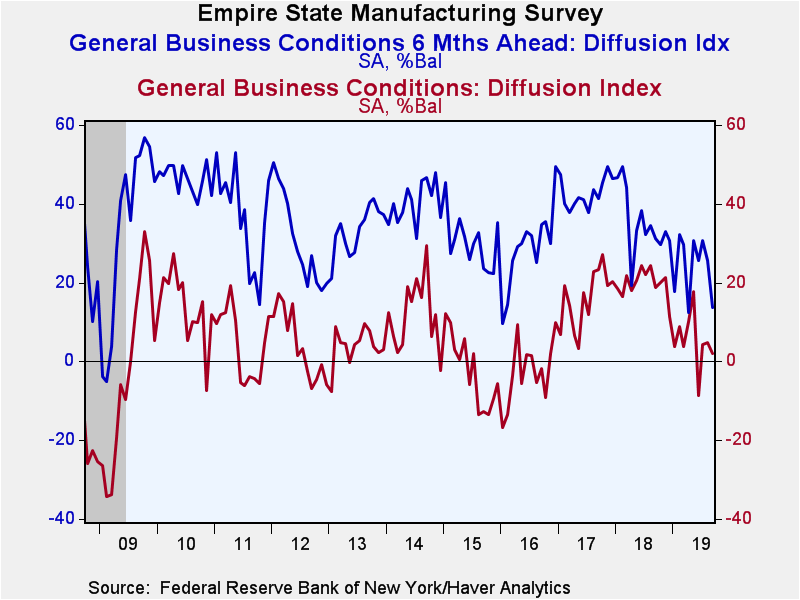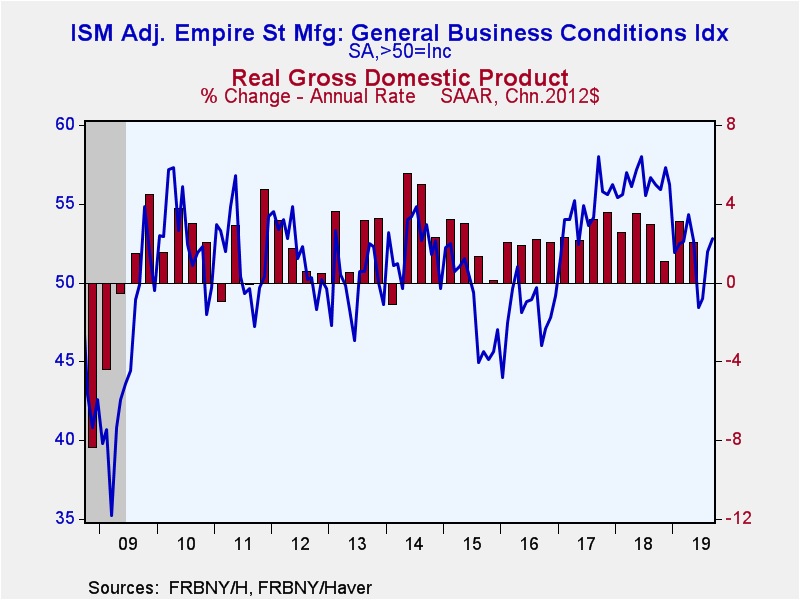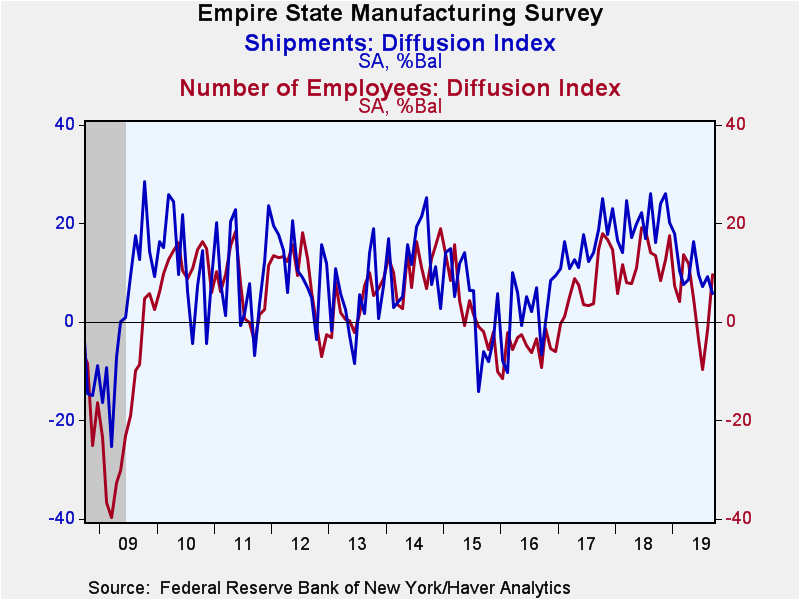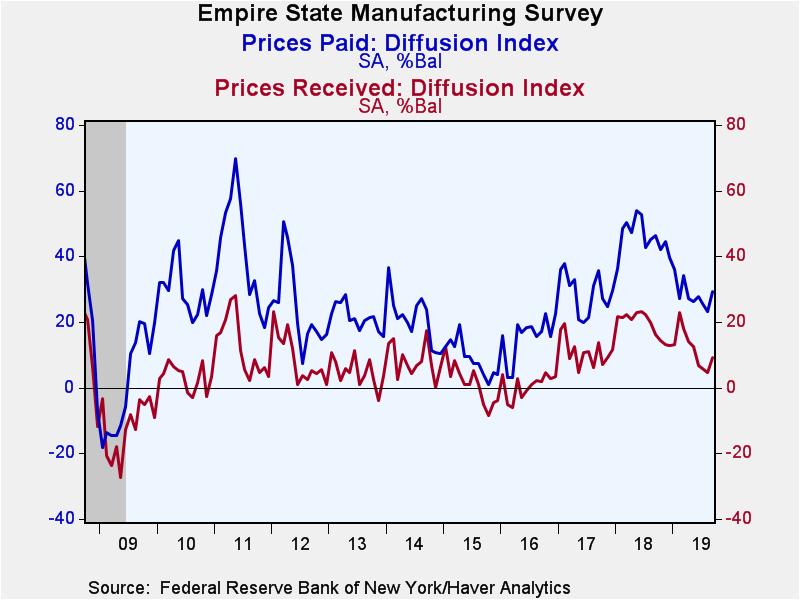 Global| Sep 16 2019
Global| Sep 16 2019Empire State Manufacturing Activity Weakens; Expectations Dour
by:Tom Moeller
|in:Economy in Brief
Summary
The Empire State Manufacturing Index of General Business Conditions for September eased to 2.0 from 4.8 in August. A reading of 3.9 had been expected in the Action Economics Forecast Survey. A steady 27% of respondents reported that [...]
The Empire State Manufacturing Index of General Business Conditions for September eased to 2.0 from 4.8 in August. A reading of 3.9 had been expected in the Action Economics Forecast Survey. A steady 27% of respondents reported that conditions had improved in September from August while an increased 25% reported a worsening. The Empire State data, reported by the Federal Reserve Bank of New York, reflect business conditions in New York, northern New Jersey and southern Connecticut.
Using the Empire State figures, Haver Analytics calculates a seasonally adjusted index that is comparable to the headline ISM index. The ISM-adjusted index rose to 52.8 in September from 52.0 in August. It was the highest reading since April, up from a June low of 48.4. A reading of 50 or greater indicates expansion in business activity. During the past 15 years, there has been a 77% simple correlation between the index level (which is a measure of change) and the quarter-to-quarter change in real GDP.
Amongst the component series in the Empire State survey, performance varied. The new orders as well as the shipments series both fell versus August. The unfilled orders, inventories and delivery times figures each improved.
Employment conditions also improved as the number-of-employees index rose to 9.7, rising above zero for the first time in three months. The average workweek index also moved above zero. Nearly one third of respondents reported increased hiring in September, the most in nine months, while a lessened 11% reported a decline. Over the past 10 years, there has been a 38% correlation between the employment index and the month-to-month change in factory sector payrolls.
The prices paid index edged higher to 29.4, the highest level in six months. An improved 35% reported higher prices while a steady five percent indicated a decline. The prices received index also rose, following six months of decline, to the highest level since May.
The series measuring expectations for business conditions in six months declined sharply, indicating that firms were more pessimistic about future conditions. Each of the components contributed to the decline with the exception of the prices series.
The Empire State figures are diffusion indexes, which are calculated by subtracting the percentage of respondents reporting declines from the percentage reporting gains. The data are available in Haver's SURVEYS database. The ISM-adjusted headline index dates back to 2001. The Action Economics Forecasts can be found in Haver's AS1REPNA database.
| Empire State Manufacturing Survey | Sep | Aug | Jul | Sep'18 | 2018 | 2017 | 2016 |
|---|---|---|---|---|---|---|---|
| General Business Conditions (Diffusion Index, %, SA) | 2.0 | 4.8 | 4.3 | 18.8 | 19.8 | 16.1 | -2.6 |
| General Business Conditions Index (ISM Adjusted, >50=Increasing Activity, SA) | 52.8 | 52.0 | 49.0 | 56.2 | 56.4 | 54.6 | 48.1 |
| New Orders | 3.5 | 6.7 | -1.5 | 17.5 | 16.5 | 14.5 | -0.9 |
| Shipments | 5.8 | 9.3 | 7.2 | 16.1 | 20.4 | 15.9 | 1.9 |
| Unfilled Orders | -2.6 | -9.7 | -5.1 | 4.9 | 3.5 | 1.9 | -8.8 |
| Delivery Time | 0.7 | 0.0 | 4.4 | 6.5 | 9.1 | 6.1 | -4.8 |
| Inventories | 8.5 | 5.8 | -10.9 | 8.9 | 5.9 | 1.5 | -9.6 |
| Number of Employees | 9.7 | -1.6 | -9.6 | 13.5 | 12.4 | 8.1 | -5.1 |
| Average Employee Workweek | 1.7 | -1.3 | 3.8 | 10.9 | 7.8 | 4.6 | -5.1 |
| Prices Paid | 29.4 | 23.2 | 25.5 | 46.3 | 45.8 | 29.0 | 15.7 |
| Prices Received | 9.2 | 4.5 | 5.8 | 16.3 | 19.3 | 11.0 | 0.7 |
| Expectations 6 Months Ahead | 13.7 | 25.7 | 30.8 | 31.1 | 35.2 | 42.7 | 29.0 |
Tom Moeller
AuthorMore in Author Profile »Prior to joining Haver Analytics in 2000, Mr. Moeller worked as the Economist at Chancellor Capital Management from 1985 to 1999. There, he developed comprehensive economic forecasts and interpreted economic data for equity and fixed income portfolio managers. Also at Chancellor, Mr. Moeller worked as an equity analyst and was responsible for researching and rating companies in the economically sensitive automobile and housing industries for investment in Chancellor’s equity portfolio. Prior to joining Chancellor, Mr. Moeller was an Economist at Citibank from 1979 to 1984. He also analyzed pricing behavior in the metals industry for the Council on Wage and Price Stability in Washington, D.C. In 1999, Mr. Moeller received the award for most accurate forecast from the Forecasters' Club of New York. From 1990 to 1992 he was President of the New York Association for Business Economists. Mr. Moeller earned an M.B.A. in Finance from Fordham University, where he graduated in 1987. He holds a Bachelor of Arts in Economics from George Washington University.










